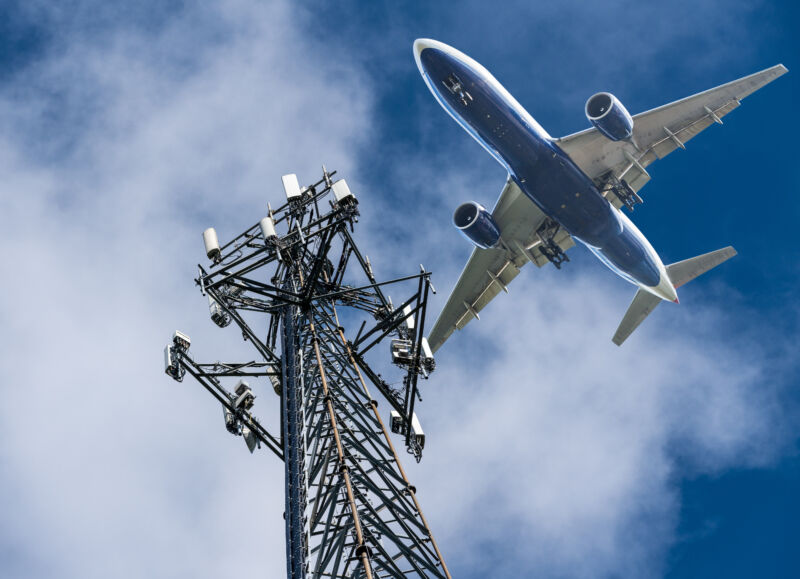
BackyardProduction/Getty
The Federal Communications Commission will consider issuing new regulations for wireless receivers that could prevent future conflicts, such as the ongoing battle between the airline and mobile industries.
There are strict rules that require wireless devices to transmit only on their licensed frequencies. That means, for example, that AT&T and Verizon’s 5G broadcasts in the C-band spectrum (3.7 to 3.98 GHz) must remain within the C-band.
But there isn’t much to stop devices from receiving transmissions from outside their assigned frequencies. The altimeters used in airplanes to measure altitude are officially based on spectrum from 4.2GHz to 4.4GHz, but the Federal Aviation Administration has said that 5G transmissions in the C-band will affect the operation of some of those. can disturb altimeters.
If an altimeter is affected by 5G, it means it is receiving transmissions from the wrong spectrum band, despite a buffer zone of at least 220 MHz. The 220 MHz guard band is actually 400 MHz this year because AT&T and Verizon haven’t rolled out above 3.8 GHz yet, but the FAA still says the current level of transmission could disrupt some altimeters. There are also satellite broadcasts between 4.0 and 4.2 GHz, but that wasn’t a problem for the FAA.
Chairman: Bad receivers “reduce wider opportunities”
In a speech Tuesday at Mobile World Congress, FCC Chair Jessica Rosenworcel said the committee must take tough action against wireless receivers. Rosenworcel didn’t mention aircraft altimeters, but explained that faulty receivers that can’t avoid transmissions from other spectrum bands could prevent new services on unused frequencies.
She went on:
In the past, our discussions about spectrum efficiency were a one-way street. They have focused almost exclusively on broadcasters. We have put in place many rules about how and when transmitters can operate to control levels of interference. But here’s the thing: wireless communication only exists when transmitters are connected to receivers. Both are vital. Both are important. And in the future, policy makers will have to consider both transmitting and receiving. Not just the former at the expense of the latter.
That’s because minimally performing receivers can make it more difficult to introduce new services on the same or nearby frequencies. They can reduce wider radio frequency capabilities and limit what is possible in the new wireless world.
FCC to request input on potential regulation
Rosenworcel said she will propose to “start a new study to examine the recipient’s performance and standards.” The inquiry’s report would call for public input on potential solutions, including new “regulatory requirements,” Rosenworcel said.
She went on:
This research would ask how receiver improvements can open up more possibilities for access to spectrum. It would explore how these specifications might come in the form of incentives, guidelines or legal requirements – in specific frequency bands or across all bands. And it would call for commentary on legal authority and market-based mechanisms that could help create a more transparent and predictable radio frequency environment for all spectrum users – new and old.
Rosenworcel said she will make the proposal in April. While the FCC still has a 2-2 partisan standoff, the Democratic chairman has bipartisan support. Rosenworcel thanked Republican Commissioner Nathan Simington “for his leadership on these issues and his willingness to work with me on a path forward.”
Simington issued a statement applauding “Chairman Rosenworcel’s decision to consider exploring a new regulatory framework for commercial spectrum allocations”. Simington’s statement went on to mention the problem with altimeters:
An approach that looks at both the receiver and the transmitter is the only framework that is truly capable of meeting the interests of federal spectrum users and other incumbent operators in a timely manner. We see a lot of value in getting to a place where conflicts like the C-band/altimeter battle are fired at the pass.
This model will provide all interested parties with sufficient advance warning of problematic band edges adjacent to a new commercial spectrum. Clear rights regarding interference protection can stimulate innovation and cooperation between spectrum users in a way that avoids regulatory requirements.
FCC urged the airline industry to take action two years ago
When the FCC voted in February 2020 to allow cellular transmissions in the C band, the committee passed power limits and the 220 MHz guard band between 5G and altimeters. “The technical rules for power and emissions limits that we have established for the 3.7 GHz service and the 220 megahertz spectral separation should provide all necessary protection for services in the 4.2-4.4 GHz band,” according to the FCC.
While the FCC found no evidence that “harmful interference is likely to occur under reasonable scenarios,” it urged the aerospace industry to conduct more tests on altimeters. †[F]further analysis is warranted as to why there is even a chance of any interference, as well-designed equipment should not normally receive significant interference (let alone harmful interference) under these circumstances,” the FCC said. warning, the FAA and the airline industry were seemingly unprepared for the 5G transmissions when the rollout occurred nearly two years later.

